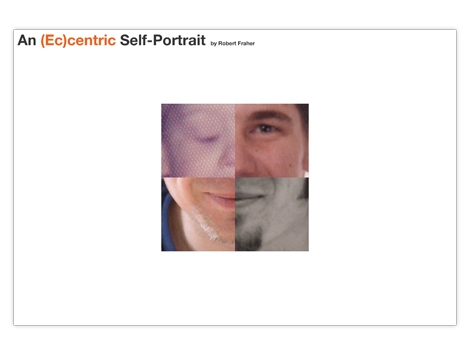An (Ec)centric Self-Portrait explores personal identity through photographic portraiture, creative writing, and interactive design.
Full Description
An (Ec)centric Self-Portrait explores personal identity through photographic portraiture, creative writing, and interactive design. The composition brings together photographs from different periods of my life that were chosen to represent my relationship to common societal roles. These visual representations of identity are juxtaposed to narrative texts that reflect on each role, and which contain links to additional content. This material is situated in an interactive environment that allows audience members to explore and experience the information in individualized, nonlinear sequences.
The structure and content of the composition are based on principles of Gestalt theory. The composition’s structure was adapted from Arnheim’s (1988) Gestalt-based theory of centric and eccentric systems. In addition to representing psychological perspectives, the concepts of centricity and eccentricity can also be represented by visual patterns.
The content of the composition was derived by considering how an oft-cited Gestalt tenet – the sum of the parts is different from the whole – could be used to convey my sense of self. Through interaction, each audience member is able to create his or her own sequence of experiences with the content, thus facilitating a unique understanding of the relationships between the roles. As a result, each audience member develops a different understanding of the whole, due to his or her personalized experience assembling the sum of its parts.
REFERENCES Arnheim, R. (1988). The power of the center. Los Angeles: University of California Press.
Work metadata
- Year Created: 2012
- Submitted to ArtBase: Tuesday Nov 27th, 2012
- Original Url: http://robertfraher.com/SelfPortrait/
-
Work Credits:
- robertfraher, primary creator
Take full advantage of the ArtBase by Becoming a Member
Artist Statement
As an artist and designer, I am interested in creating compelling experiences for people through interactive computer-mediated communication. My work explores the context of the computer interface as an environment for both emotional and cognitive engagement. The two main purposes of this exploration are to help people 1) develop a more acute mode of interpretation in light of the complexity of contemporary media; and 2) experience the exhilaration that can result from creative participation.
To accomplish these outcomes, my work involves an interdisciplinary approach to the medium of human-computer interaction. The disciplinary perspectives involved in this approach include art, design, psychology, sociology, computer science, and instructional design. The structure of my inquiry commonly follows a design exploration process, in which the fundamental research question often begins with “What if…” As such, much of my work explores establishing new connections between disparate epistemologies.
My current creative activities center on exploring how interactive design and digital media can be used to facilitate individual expression and community involvement. This exploration includes considering topics ranging as widely as the therapeutic potential of digital media and current trends in online social media. The unifying characteristic of these activities is my intent to help people through creative processes, both theirs and my own.
My previous work has investigated the relationship between multisensory feedback and a person’s sense of immersion, as well as the concept of agency in novel computer interfaces. My immediate goals include pursuing increasingly compelling experiences for the audiences of my work, and continuing to contribute to the next generation of interactive artists and designers as a faculty member in higher education. The shared result of these goals will be the production of interactive artworks that promote understanding and foster community.
